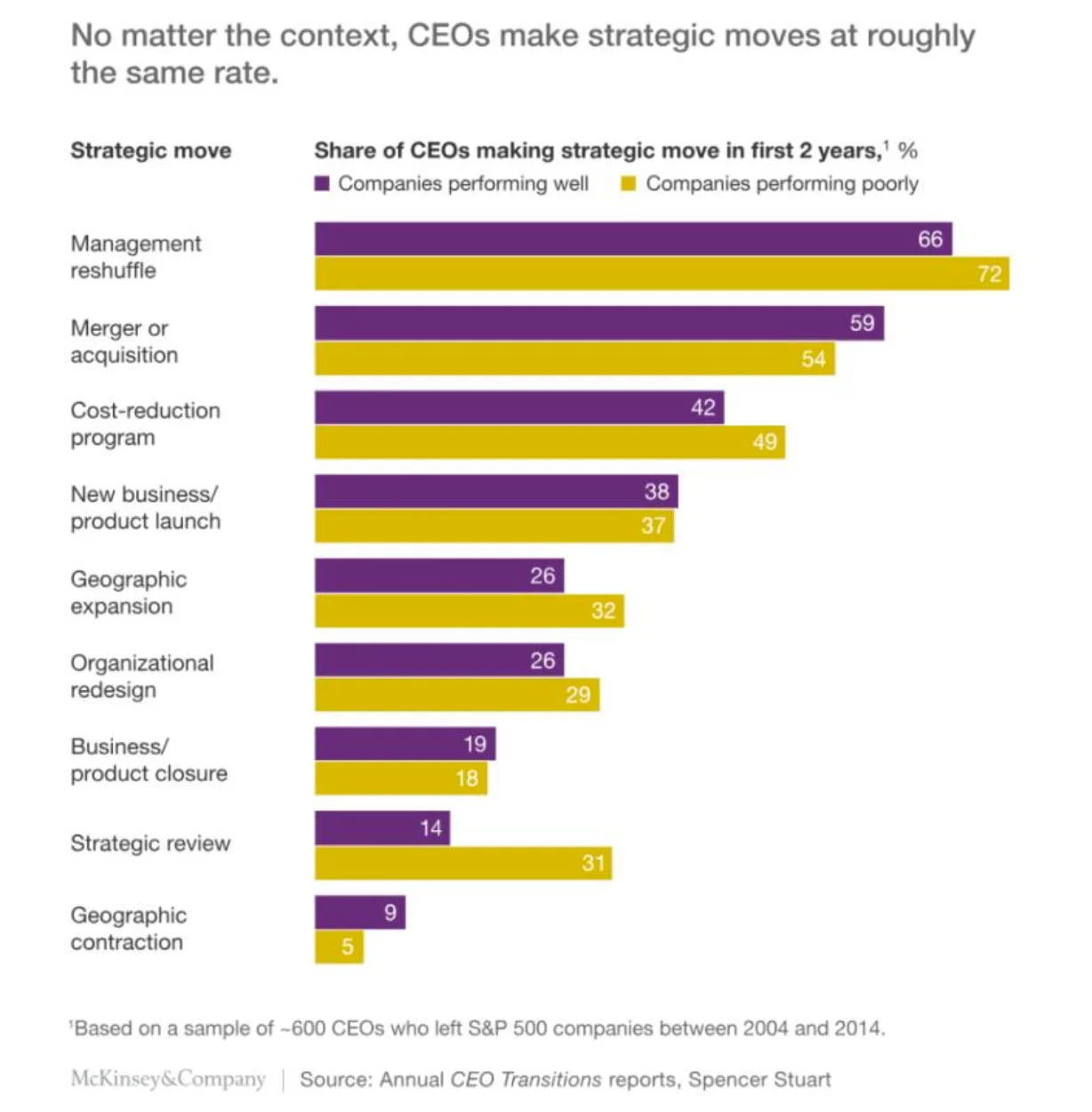CEO Life in 2023 is Tough: Four Things CEOs & Companies can do to Boost Tenure, Thwart Complacency and Improve Bad Succession Planning
The role of the Chief Executive Officer (CEO) is without a doubt the most
significant leadership role within a company. Whether an S&P 500 or start-up,
the CEO is the face of the business; he or she shapes organizational culture
and embodies what the company stands for, and is accountable for results.
For better or worse, awareness of the significance of the CEO role has
extended beyond the world of business and into popular culture. The reputation
of the CEO can live or die based on the professional and personal actions he
or she takes, and, as a result, what is said about him or her on the Internet.
CEO Turnover
At the same time, CEOs are getting less time to make their mark on an
organization; median tenure for CEOs at S&P and large-cap companies has
dropped from six to five years since 2013, according to the Harvard Law School
Forum on Corporate Governance and Financial Regulation. 1
So the question becomes: If CEO tenure is shrinking and public scrutiny is
growing, how can CEOs and organizations drive performance despite greater
internal and external challenges?
This white paper reviews trends, practices, and opportunities that companies
can take advantage of to improve business performance by:
- Optimizing the role of CEO
- Examining CEO turnover & Average Tenure
- Setting up long-term success with a pipeline of diverse future leaders.
Understanding these issues will help unwanted CEO turnover and help companies
plan their CEO successions.
The Role of the CEO
A CEO is the highest-ranking executive in a company. The role of chief
executive officers is to be the main point of communication between the board
of directors and the C-suite, and are responsible for managing the overall
operations and resources of the company. 2
On a less operational and more human level, CEOs set the tone and vision for
their organizations. What the CEO says and does affects how employees and
customers perceive the organization—inside and outside the office.
From the outside world the life of a CEO may seem glamorous but in actuality,
the day in the life of a CEO and the truth about CEO life is quite different.
Today’s CEO lives an increasingly public life in which his or her actions can
be disseminated and dissected by anyone with an Internet connection. This
relatively new dimension to the role has been cited as one of the reasons why
average tenure has been falling in recent years.
Between greater scrutiny, higher short term shareholder expectations, and
existing business risks, both younger executives and senior executives in
publicly traded companies as well as private companies are rethinking their
career trajectories.
As leaders are considering the changing landscape so are companies in terms of
their strong leadership mandate, the impact of forced CEO departures, CEO
succession announcements, and interim CEO appointments.
So, What is the Average Tenure of a CEO?
The CEO position was once viewed through a more long-term lens; however,
current average tenure lasts much closer to five years. In 2017, almost half
of CEOs at S&P 500 and other companies had been in their position for five
years or less, according to the Harvard Law School Forum on Corporate
Governance and Financial Regulation. 3 This data includes CEO’s who leave on
their own as well as forced CEO departure.

There are three possible reasons for the fall in tenure and shrinking of the
CEO tenure and life-cycle of CEO’s over the past five years.
- First, research shows that new CEOs are often more effective than long-tenured CEOs: new CEOs bring new ideas and energy, while older CEOs can become myopic and more risk-averse. 4
- At the same time, CEO exits from underperforming companies are on the rise. In 2016, the succession rate of poorly performing companies rose 40%, according to The Conference Board. 5
- Third, the increasing transparency of a CEO’s actions has ushered in a new era of accountability, with forced turnovers due to ethical lapses increasing 36% from 2011 to 2016, according to Price Waterhouse Coopers. 6
Given the shrinking and shorter average tenure timeframe in which CEOs have to
act and the increased public scrutiny of the role, here are four ways CEOs and
organizations can drive performance:
- Make Strategic Moves Early On
- Remain an Outsider
- Embrace the Public Nature of the Role
- Create a Diverse Pipeline for Effective Succession Planning
What Can Be Done To Extend The Average CEO Tenure?
One of the results of falling average tenure has been CEOs’ taking decisive
action quickly after stepping into the role. This makes sense, as new CEOs
must make their mark against the backdrop of a ticking clock.
CEOs better make the right moves right now, or their jobs may not be theirs
for as long as they want.
Luo, Kanuri, and Andrews reinforce the notion that early on is the ideal time
for new CEOs to make big moves. They posit that as outsiders to the
organization, new CEOs are more attuned to and therefore more responsive to
the external environment, which assists them in strengthening the
organization’s relationships with customers.
McKinsey has identified some common actions new CEOs take when they start
their tenure, including reshuffling top management, mergers and acquisitions,
cost-cutting programs, and new product launches.
It is important to note that these bold strategic moves tend to be higher
risks for CEOs of well-performing companies.
If the company is already doing well, a bold, new initiative carries the risk
of setting the company down a less successful path—“Don’t fix what ain’t
broke,” as the saying goes. But if the company is not performing well, then
shaking things up is usually welcomed, as there is less downside to calculated
bold action.

1. Remain an Outsider
While new Chief Executives are praised for their decisive actions and outsider
thinking, more tenured CEOs at S&P 500 and other companies labor under the
perception of being too inward-focused and risk-adverse. According to Luo,
Kanuri, and Andrews:
“In their later seasons, however, CEOs myopically commit to obsolete
paradigms, become risk averse and stale in the saddle, and tend to adapt less
to the external environment… thus hurting firm performance.”
Research by PWC reinforces this notion of a detrimental “insider” perspective.
In their 2016 Chief Executive Success Study, they found that Chief Executives
hired from outside the organization have delivered higher median total
shareholder returns than insiders for the past four years.
As tenure increases, it is easy to become entrenched in what you know and less
open to outside information. The message here is clear: CEOs at S&P 500 and
other companies must maintain an outsider perspective to be able to adeptly
respond to what is happening in the market. An outsider perspective is one
that is characterized by market/external focus, growth/innovation centricity,
and optimizing of company culture.
2. Embrace the Public Nature of the Role
Over the past five years, the percentage of CEOs at S&P 500 and other
companies forced out of office for ethical transgressions increased in every
region analyzed by PWC:
- U.S./Canada: 1.6% to 3.3% – 102% increase
- Western Europe: 4.2% to 5.9% – 41% increase
- BRIC Countries: 3.6% to 8.8% – 141% increase
Furthermore, total forced turnovers for ethical lapses rose 36%, from 3.9% to
5.3%.
With the proliferation of digital paper trails—which hold CEOs and other
leaders accountable for the decisions they make—and the 24/7 news cycle—
which increases the likelihood that word of an ethical lapse will go viral—it
is important for CEOs to scrutinize their own actions through the lens of
public perception before acting on them.
CEOs must see themselves as public figures, embracing the public nature of
their roles and using it to their advantage. This is not about exploiting
public opinion. With people growing increasingly wary of big corporations and
the people who run them, any whiff of deceit will undoubtedly be discovered
and used against you. This is about genuinely connecting with internal and
external audiences and acting in a way that is aligned with their—and
hopefully your—ethics.
As the CEO, how would you feel if whatever action you are about to take became
the front page headline of The Wall Street Journal? How would your board feel?
Let those answers be your guide.
3. Create a Diverse Pipeline for Effective Succession Planning
One other possible reason for shorter CEO tenures is poor CEO succession
planning on the part of organizations. A PWC 2016 CEO Succession Study noted
that CEOs who step into the role after a forced exit have shorter tenures than
those coming in after a planned CEO succession, a median of 4.2 years compared
with 5.6. They posited that “companies that lack good succession plans are
setting themselves up for more frequent turnovers.”12
Furthering this point of view is that in the past 15 years, higher performing
companies have had planned turnovers 79% of the time versus 55% of the time
for low-performing companies, according to the study. Better performing
companies plan for departing CEOs, they position themselves for seamless
leadership turnover from CEO succession announcements to supporting the new
CEO as they integrate into their role.
At the foundation of successful CEO succession planning is a pipeline of
strong and diverse future leaders. One clear area where most companies are
failing with CEO successions are in the lack of gender diversity in their
pipelines.
In 2016, only six of the 63 CEO positions that became available in the S&P 500
were filled by female CEOs. And while this figure seems sadly low, the total
number of women CEO appointments in Fortune 500 is at an all-time high of 32,
which, perhaps, makes it even sadder. These numbers are also the same in terms
of interim CEO appointments. These low numbers reflect the trend of departing
female CEOs.
There are many reasons why women CEOs remain elusive, most of which have to do
with poor CEO successions. In a business world that has long been run by men,
women have simply not had the range of opportunities, broad experience, or
professional networks necessary to be hired for or be as successful as male
CEOs. This begs the question of what do public companies and private companies
need to do to support the pipeline of future and incoming female ceos?
To promote diversity in pipelines and, ultimately, future organizational
success, companies must provide leadership roles and development opportunities
for women, so that when CEO and other C-suite positions become available,
there are women primed to perform at that level.
Conclusion
Today’s CEO has a shorter time-frame in which to make his or her mark. In
addition, there is increased public scrutiny on every move made—inside or
outside the office. This environment calls for new thinking and actions for
CEOs and organizations to drive performance. These four actions include:
Incoming CEOs: Make the Right Strategic Moves Early On
New CEOs have to make the right moves right now, or the job may not be theirs
for as long as they want. For incoming CEOs, the “right moves” will depend
upon current performance, changes that are truly beneficial, and having the
right metrics in place.
Remain an Outsider
As tenure increases, CEOs can become entrenched in what they know and less
open to outside information. CEOs must maintain an outsider perspective to be
able to continue responding to what is happening in the market. Today’s CEO’s
mindset must be one of growth, innovation, and company culture evolution.
Embrace the Public Nature of The Role
The proliferation of digital paper trails, the 24/7 news cycle, and increased
skepticism regarding big business means every move a CEO makes must be
evaluated through the lens of public perception—before it is acted upon. CEOs
must embrace the scrutiny of the job and the fact that like professional
athletes or actors, they are in the public eye.
Create a Diverse Pipeline for Effective CEO Successions
Weak pipelines can lead to unprepared and low-performing CEOs. To drive future
organizational success, companies must provide leadership roles and
development opportunities to diverse populations, so that when CEO and other
C-suite positions become available, the right people for the jobs are primed
to perform at that level.
Resources:
- https://corpgov.law.harvard.edu/2018/02/12/ceo-tenure-rates/
- https://www.investopedia.com/terms/c/ceo.asp
- https://corpgov.law.harvard.edu/2018/02/12/ceo-tenure-rates/
- How does CEO tenure matter? The mediating role of firm-employee and firm-customer relationships
- https://corpgov.law.harvard.edu/2017/07/31/ceo-succession-practices-2017-edition/#more-9978
- PWC, 2016 CEO Success Study: Global Findings
- How does CEO tenure matter? The mediating role of firm-employee and firm-customer relationships
- https://www.mckinsey.com/featured-insights/leadership/how-new-ceos-can-boost-their-odds-of-success
- How does CEO tenure matter? The mediating role of firm-employee and firm-customer relationships
- PWC 2016 CEO Success Study
- PWC, 2016 CEO Success Study: Global Findings
- PWC 15th annual CEO Succession study







